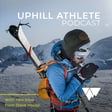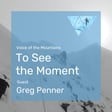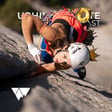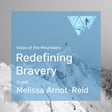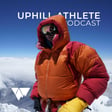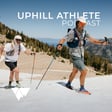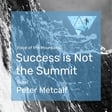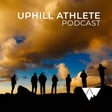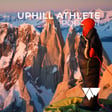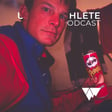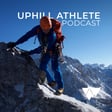Become a Creator today!Start creating today - Share your story with the world!
Start for free
00:00:00
00:00:01

Author Jim Nelson shares his latest guidebook: Classic Cascade Climbs
In this episode Scott Johnston welcomes his long-time friend and fellow sexagenarian climber Jim Nelson. Jim and Scott discuss Jim's latest guide book. Classic Cascade Climbs.
Jim, with co authors Tom Sjolseth and David Whitelaw have just published a follow up to his 2 previous Selected Climbs books. This one; Classic Cascade Climbs, published by The Mountaineers Books is sure to fire the imagination of even the most seasoned climber. While giving plenty of relevant beta for the climbs the killer photos are going to make you want to leave this book on your coffee table as inspiration.
Link to purchase book:
https://www.mountaineers.org/books/books/classic-cascade-climbs-select-routes-in-washington-state
Transcript
Introduction to Uphill Athlete Podcast
00:00:00
Speaker
Welcome to another episode of the Uphill Athlete Podcast. I'm your host, Scott Johnston, co-founder of Uphill Athlete. These podcasts are just one of several free services we provide to the mountain athlete community. We have a ton of free content on our website, uphillathlete.com, to help you with any of your mountain pursuits, be they mountaineering, alpinism, skimo, ski mountaineering, or mountain running.
Classic Cascade Climbs Guidebook Highlights
00:00:24
Speaker
Today, I'm pleased to welcome my friend and fellow sexagenarian climber, Jim Nelson. Jim and I are going to be discussing his latest guidebook, Classic Cascade Climbs.
00:00:36
Speaker
Jim partnered with co-authors Tom Solseth and Dave Whitelaw. And they've just published this book. And it's kind of a follow up to the previous two books that Jim had done with a different author. There were two volume set of selected climbs in the Cascades. This one, Cascade Climes, classic Cascade Climes, published by the Mountaineers Books.
00:01:00
Speaker
is sure to fire your imagination of even the most seasoned climber. While giving plenty of relevant data for the climbs, the killer photos are really going to be what leave this book on your coffee table as an inspiration.
00:01:14
Speaker
It seems to me, as an older generation climber, that guidebooks have become sort of passe and are being replaced by apps with very detailed topos that describe in micro detail what size gear to place where. Sure, like a repair manual for a car, this type of guide will definitely be the quickest and easiest way to get familiar with the route.
00:01:36
Speaker
But for my taste, what's been lost with this clinical approach to climbing guidebooks is that it reduces the routes down to some numbers. And it's lost some of that romantic appeal that should be, I think, or what does probably drive most of us towards climbing.
Inspiration vs. Practicality in Guidebooks
00:01:53
Speaker
Jim's uniquely qualified to write a book like this. His climbing career started in the early 70s, and he's got enough notable ascents to make up a book, all of them all on their own. To mention just a few, Jim did the second ascent of the infinite spur on Mount Foraker with Marc Bivier.
00:02:14
Speaker
He did an eight-day first winter ascent of Mount Sletsey's northeast buttress with Kit Lewis. The second descent of that was not done until 29 years later by Marc-Andre Leclerc. He pulled off another brutal eight-day stormy winter climb of the girth pillar on Mount Stewart with Kit Lewis. Definitely shows that Jim's not one to shy away from Supperfest.
00:02:44
Speaker
And so as might be expected for a climber of his stature, Jim and Fred Becky hooked up and racked up quite a few first ascents together. With the breadth of his experience spanning five decades, Jim is uniquely positioned to bring to our attention so many of the roots that are more obscure, but still really worthy.
Serene Routes and Photography in Climbing
00:03:05
Speaker
With the wild growth and the popularity of climbing, the most popular routes in the Cascades can be a kind of a crowd scene. Jim sheds some light on some really fine climbs that should allow you to experience a bit more solitude and serenity.
00:03:21
Speaker
I think this book should be in every Cascade Climbers library. And even those folks that are traveling here, which is to the most alpine range in the Lower 48, will definitely benefit hugely from snagging a copy of this thing.
00:03:37
Speaker
caused you to be rethinking maybe some of the routes you had picked out. Also, if you're looking for the best year around or route beta or even just a good story, Jim's the owner of Pro Mountain Sports in Seattle and you should definitely pay him a visit if you're in the area.
00:03:55
Speaker
So let's get with it. Well, thanks for agreeing to let me subject you to this. Hopefully it's not too painful. But I think that what you've done with this book is really cool. I love looking through it. I've read most of the descriptions. I have to confess that I'm envious. I'm kind of jealous. I would love to have climbed more of those roots that are in that book. Me too.
00:04:22
Speaker
Thank you for putting that together. It's just lovely pictures. I really like the pictures. I find, and I'm sure many climbers do. I mean, we're inspired by beauty and there's so many beautiful pictures in there that it gets your juices flowing for sure. And I hope that, I would assume that was part of your attempt, your intent. Excuse me. No, it's always nice to hear that. But yeah, pictures are, we love the pictures.
00:04:50
Speaker
We put a lot of them in there. There's a lot of information and pictures and yeah. Well, and some of them look like they were on Kodachrome. Some of them are pretty old. I have to say they're not digital. I can tell that and some of those people. Yeah, the dates. Yeah, that's pretty cool. Did you have any trouble rounding those old photos up? Most of my pictures are on film. What are you talking about? I mean, some of them aren't yours, I guess is what I imagine.
00:05:20
Speaker
Um, well, I just, I guess from the previous books, I've, I've met a lot of, a lot of people. And so I had a lot of, a lot of, um, friends and resources to draw on, but of course the skirlock photos are, you know, that's, that's just a huge library of, you know, every angle on, on almost every peak you want. And if there's something you don't have, like I didn't have, he didn't have a tooth or an Ingalls peak. So he, you know, he says, oh yeah, I'll just, I'll go take some. So.
00:05:51
Speaker
What a guy. For those listeners that are not familiar with John Scurlock's photographs, you should be. He's one of the most amazing mountain photographers I've ever seen. And he does them all while flying a small plane around these mountains. And so their aspects are angles and views that you won't really get from the bottom of the valley looking up.
00:06:14
Speaker
but they're really stunning and spectacular. So I recommend people try to track down some skirlock photos of their favorite climbs. Yeah, and artistically too. I mean, gosh, some of the prints I've seen of
00:06:31
Speaker
Yeah. Yeah, I have one of the North Face, that really famous one, or not really famous, I think it's pretty, one of his more famous ones, that North Face of Mount Triumph that shows the Northeast buttress, the Burdo Dorish route, and then it also shows the more popular East Ridge in profile. So it's quite a beautiful picture.
00:06:55
Speaker
Yeah no it's a stunning peak and it's interesting I think our first book I actually had a pictures before I even knew John Scurlock or I don't think he was even taking pictures yet but I was able to fly around the Cascades a couple times years ago in the winter and I had a picture of a triumph in the you know the north side there you know just a stunning winter shot that I think is in our first book.
Evolution of Guidebooks and Online Resources
00:07:20
Speaker
Yeah, let's talk about how you came to write this book. I mean, you've written a number of books on climbing, and yet there are two of your more popular ones that I think people are still using today, the selected climbs of the Cascades, the first and second. There's two volumes, first and second volume of that. So how does this build on that book, those books?
00:07:44
Speaker
Well, how does it build on the, well, it's really just a redo of those two books. I mean, the original one was popular enough that the publisher wanted a second one. So that was why there was a second. And then, you know, they're old enough now that
00:08:05
Speaker
There's, you know, rethinking the whole thing. I think the new book, we have a much better selection of climbs that shows the different types of climbing better as well as more geographic areas. And, of course, they're able to do color printing now, which they hadn't previously, so.
00:08:30
Speaker
Yeah, well, the color makes a huge difference. I mean, I know we've all of course, relied for many, many years on the Fred Beckies books, which look like the kind of many cases, some of them look like the drawings that you know, you we might have done in third grade. So they're kind of difficult to find the roots and follow them. But yours, these beautiful photographs, and the lines drawn on them really do help
00:08:55
Speaker
identify features and roots and and even better than you know your previous book which was black and white so previous books excuse me so I think that's a big plus for it and so go ahead sorry excuse me look like you're gonna say something well you and of course now there you know with the internet the amount of in route information is endless and so you know we tried not to overdo the route information and more just
00:09:24
Speaker
give everybody basically an introduction or an overview of the Cascades. This was really the idea. Sure. And then if somebody sees one of those routes that's inspiring to them, they can go dig a little deeper online and probably get... Talk to Mr. Google and you'll start. There's no end to the information. So, I mean,
00:09:48
Speaker
Obviously, we can make some nice observations and give some important information, but we try not to overdo it and let the pictures speak for themselves, I guess.
00:10:00
Speaker
So what were some of the, what are the different, what are some of the roots that are included in this book that either weren't included in the previous editions or previous, the two previous volumes of selected climes or are especially interesting to you because they were kind of obscure, but you're finding out that they're, now they become more popular. As you, I know you said that
00:10:26
Speaker
the first two volumes of your book caused some renewed interest in some more obscure climbs and which ones would those be that you think that were most brought to light by those books? Yeah, I mean climbing wasn't nearly as popular than I guess that's probably part of it but a lot of the climbs in that first book were climbs that I had done multiple times. I've always enjoyed repeating routes and
00:10:53
Speaker
I was doing a lot of guiding at the time, and so looking for climbs that wouldn't be too difficult for my clients. And so climbs like the Kinsabi Glacier, if you can believe it or not, or Colchek Peak, just really dead obvious climbs these days that are extremely popular. They basically had no traffic back then until the book, really. I mean, Kinsabi Glacier, I never saw tracks or another party on there.
00:11:24
Speaker
ever, you know, before, you know, I don't even remember what year the first book was, but it's probably like, I want to say mid 80s or something. Yeah, yeah. Yeah, South, the Southwest gully of South early winter spire was one I always, you know, it was when the highway opened, I'd be anxious to get up there on my skis. And, you know, obvious route to bag bag the nice summit there. And again,
00:11:52
Speaker
never was anybody doing that climb. In fact, one of the reviews, the reviewers of the first book criticized the choice of that route, saying that it was a terrible route, loose rock and dangerous. And of course, this is all true once the snow's gone, but that was the whole point. We were trying to show, you know, get out of the rut of
00:12:23
Speaker
you know, a little bit more off-season suggested not, you know, the snowier season or, whereas in this, we did the same thing with the first book with some more mixed climbs, you know, more winter routes or early spring routes or that were basically fairly unknown at the time. Well, that the kind of the Northeast
00:12:50
Speaker
based on cutthroat that little there's a little ice climb there yeah yeah that's a great climb i've enjoyed that climb a few times you know hard to get the right conditions for it but yeah i've i've gotten part way up at a couple of times it had to bail because of conditions but one time steve steve house and i managed to hit it in really good climbing ice conditions in in early may and yeah it's it's a fun climb definitely worth doing yeah it's so accessible so you know
00:13:20
Speaker
Yeah, you don't need it. Yeah, the conditions you can just jump on it when you read a trip report on the internet now, right?
00:13:28
Speaker
Yes, exactly. Yeah. But maybe that's something that you and I should delve into a little bit. I mean, we're kind of from another generation than this whole internet generation.
Route Finding Skills in Modern Climbing
00:13:39
Speaker
And, you know, I know from your experience, your climbing, your climbing career and resume is not too dissimilar to my own. We started at roughly the same time, kind of high school age and in the early 70s and kind of have
00:13:56
Speaker
been riding it ever since, as much as our old bodies will allow us to. But the changes that we've seen over the years, where I know that when you first started going to Canada to climb, like I did, the information, let's say, and I think probably here, I wasn't climbing in the North Cascades then, so I can't comment on that. But I do know that going to the Bugaboos and the Canadian Rockies in the 70s, their information was so sparse.
00:14:26
Speaker
And the things that they call guidebooks today, what we would call laughable. Some massive roots that would have just the sparsest information of how to even find the base of the climb. Well, like for the bugaboos, for the bugaboos back then, the best information was the hot log when you got there. Yeah, exactly. Yeah.
00:14:49
Speaker
Yeah, I know you and I both climbed the Becky Chouinard on South Houser around the same time. I think I might have climbed it a couple years after you did. And at that time, there was very little information other than that it was, I think, 5982 or something like that.
00:15:09
Speaker
So, we asked the hut warden, you know, has it ever been free climbed? And he said, no. So, he said, oh, like, we think we can handle that. We'll try it. And we did manage to free it. And we came back and the hut warden said, yeah, I think that's the first free ascend to that thing. But it was just like, okay, so now that information's in the hut log, and that's it. You know, it doesn't go into, there's no internet. There's, there weren't even, you know, if something did manage to make it into a magazine,
00:15:35
Speaker
It might be two months or more after a climb was done before the information might see the light of day in the public's eye. I like what we've seen, the transition we've seen. It gives people much more ready access. Guys like you and me who've been around a long time, I feel like we're kind of playing catch up a little bit.
00:15:57
Speaker
I mean, I still don't quite get the phone apps that have all the climbing routes on them. I struggle with using those things. I'm sure you have some similar experiences and some similar feelings. Yeah. Well, no, I don't hesitate to use the information. I'm always curious to see what people are suggesting. You get a good suggestion on how to avoid a bad section or
00:16:26
Speaker
a little variation that might be an improvement or some data on what to take with you, et cetera. Yeah, I can imagine when you and Steve Swenson climbed the North Face of Mount Temple, I'll bet you did not have a super topo guide. Well, we knew nothing. I mean, I can't even remember. I think there probably was a guide for the Canadian Rockies. That's how we knew about the climb. But I think, yeah, we just
00:16:57
Speaker
Route finding I think has just always been part of we never really look to detailed information. We just sort of, you know, route finding was always part of the just part of what you did.
00:17:11
Speaker
And I feel like that's a skill, and I mean, I'm not trying to be pontificating here, but I do think it's an important skill that climbers have to be able to look up and think a ton of when you're looking up at the route and you're on the route or you're even deciding the next three moves, let alone the next three pitches, I think it's a valuable skill to be able to put yourself in the mind of the first ascensionist and think, okay, if I was the first person up here, where would I go?
00:17:41
Speaker
And generally, the first ascensionist is looking for the easiest way up. And I think that that often gets overlooked these days. In my experience, when I've been guiding or just been in the mountains in general, I come across people who struggle with route finding because they don't have that kind of first ascensionist mindset. They're looking for some landmark. And if you're following the place where other people went off route, then you're going to go off route as well.
00:18:12
Speaker
Yeah, I'm usually looking where the rock's the most solid, I guess. But I mean, that's just for rock climbs. And then for more mixed routes, the conditions often dictate your choice of route. Yeah, for sure. So when this book, did you decide to go, I think you said the Mountaineers published this book.
Creating the New Guidebook with the Mountaineers
00:18:35
Speaker
Were they the ones that published your previous books as well? Yeah, they published the previous ones.
00:18:39
Speaker
the first one, and then they asked for a second one. And so, yeah. But it's been a few years since those books have come out or been out. Was it were they did they come to you with this idea? Hey, Jim, we need some new book or did you approach them and said, like, yeah, no, they they approached us and they want us to put the two books together into one, which only makes sense. And at that point, you know, I was I got the more I started working on it, the more excited I got. And, you know,
00:19:09
Speaker
trying to decide how to put together which climbs to choose. Some of the climbs that we really missed the first time were a couple of big climbs done by Pete Dorrish. So got in touch with Pete and had a great time hearing about his climbs and his trips and got a lot of valuable information just about a lot of climbs.
00:19:38
Speaker
Yeah, well, like I said, for folks that haven't seen the book, I highly recommend you get a copy. Even if you don't live with ready access to the North Cascades, it's mouthwatering and it will definitely get you fired up too.
00:19:54
Speaker
to go climbing in this area. I really, like I said, at the beginning, it kind of made me wish I was 20 years younger, getting out there and still chasing after those kind of climbs. Did you find that some of the climbs I know are newer, and they weren't even done when you wrote those other two books. And how did you decide which of the newer climbs to put in?
00:20:24
Speaker
Well, um, as with the previous books, we've always included some sort of mixed routes, more winter climbs, if you will. Um, and, um, so we want to do that again. And rather than just, you know, repeating the ones we had shown previously, um, I guess the one that really comes to mind to me is the one on, um, white horse. Oh yeah. Mm-hmm. Uh, Ralph Larson and, um, uh, Pete Hurst ground.
00:20:51
Speaker
A route that I had also seen from the air years ago and was just quite taken by it. So yeah, we included that one. It's done fairly recently. I'm sure it hasn't had a second ascent. And so there is all you mixed climbers. There's an attractive line that's close to Seattle.
00:21:14
Speaker
has a moderate approach, doesn't have a multi-day approach at all. It's, well, nowadays, I guess everything they do in a one day, right? Exactly, yes. I mean, I think the first descent party spent a day on the approach and a day for the plime. And then also we try to, besides just the route information, we try and include some history too, as we learn more about the
00:21:41
Speaker
Like one thing we didn't have in the previous books was any, I'm just sort of backpacking traverses or mountaineering traverses, if you will. Like the tarming and traverses, the one everybody knows. Where else is there is information on the tarming? I mean, in written format. Well, if you buy our book, the tarming and traverse chapter, we have a chapter for the tarming and traverse.
00:22:10
Speaker
although to get the full tarming and traverse history of the original Tarvians who made this traverse back in the 30s, 1938 I think, we quote from an article that was written in the 50s by Harvey Manning and so you can access that online with the Mountaineer annuals are archived and so we give the
00:22:38
Speaker
the year and how to access stuff like that. In fact, you can, with pretty much any climate you're interested in when you're looking through the book, if you want to read about the first ascent, you can oftentimes find the write-up of the first ascent in the mountaineer annuals that are, like I said, available online.
00:23:01
Speaker
Well, I know you had, there's a nice picture. I've always wondered what Herman Ulrich looked like. And somehow I pictured him to be a little more round, cherubic, older German gentlemen. But instead, what I saw is these lean, ripped young man in those pictures. And I thought, okay, this is, I completely changed my, like, my mental picture of this guy.
Early Climbing Challenges and Pioneers
00:23:27
Speaker
Yeah, very bold rock climber, you know, at the time, you know,
00:23:31
Speaker
He's obviously a very skilled rock climber, some of the solo rock climbs that he had managed. He's soloed Sir Donald, the Bear Creek Spire in the Sierras. I guess there's no easy route up, but I'm not really familiar with it. But I'm told that it's one of the more challenging peaks. And the first ascent was made by Herman as a young teenager solo.
00:23:56
Speaker
Yeah, it is interesting. I like seeing pictures like that because it's one thing to read about these people and it's another to see them and see them in their heyday, their glory days, when they were young and virile and fit and all that. And then you realize, oh, that's how this person did all this stuff because he has an amazing history here and all over, but especially in the Northwest here.
00:24:23
Speaker
Well, Hermann Ulrichs was only in the Cascades in Seattle for a few years. But the amount of climbing at a time when the mountains were so unexplored, really, he was the first to even think of doing winter climbs. And one of the early peaks that he attempted was Mount Index. In winter. In winter. And again, this is in the 20s.
00:24:49
Speaker
Oh, that's very impressive. Very impressive. Yeah. I mean, they were just opening, they had just opened the road over small quality pass. You know, you could drive up there for the first time. And so just getting to many of these peaks was no easy task.
00:25:10
Speaker
Not at all. No. And I think it's, you know, we are in a sport where the history of the sport is, um, luckily it's pretty well chronicled now. And I think we, I feel that we contemporary climbers and I'm not, I don't put myself in the category now anymore of a contemporary climber. I'm kind of an old man, but I feel that
00:25:37
Speaker
I've always been interested in the history. You know, I grew up in Colorado and the legacy of people like Leighton Core and folks like that and then, you know, I started climbing in the Canadian Rockies a lot and there was stories about Bugs McKeeffe and this, the legacy of those people, those early climbers has always fascinated me and it's also inspired me because I realized they were
00:26:01
Speaker
They were dealing with conditions and approaches and whatnot that we don't have to manage anymore. You and I were having a conversation earlier a few weeks ago about Herman Ulrich's climb of Silver Star Mountain.
00:26:17
Speaker
near Washington Pass. And you mentioned him, he went up Cedar Creek and then up the West Fork of Cedar Creek. It's a heck of a long way. And tell me, remind me that story. Didn't he go from the trailhead to the summit in one day? No, he spent, they took all day to get to Winthrop, basically. They had an epic drive over Silicon Pass. At that time, Blue Pass wasn't there.
00:26:46
Speaker
So they cross the Columbia River advantage and then they drive up and then, and then, um, eventually after the met that they get to Winthrop at four in the afternoon. They don't know anything about this map, this mountain, other than this map that had just been published by this, uh, forest forest service as a result of a Winthrop ranger by the name of log you weren't stat who's a whole nother story. Um, but.
00:27:11
Speaker
So yeah, they're in Cedar Creek Trailhead at five in the evening, and then they hike up all the way up Cedar Creek, and then up this branch up under the south face of Silver Star that evening in September. Yeah, and the days were short, so they were hiking probably in the dark by the time they got to their campsite, I would say. It's several miles up there for sure. Well, the last bit, last
00:27:40
Speaker
2,000 foot climb up to the below the south face to a little basin up there in Little Meadow. There's a little bit of a climber's trail now. It's not easy to find. It's a real sketch. Of course, when Herman was there, there was no trail at all. I mean, there was a trail up Cedar Creek, but then at some point they leave that trail and they head on up the steep hillside.
00:28:04
Speaker
Yeah, I think a lot of the trails around here, which when I say here, I mean that area, Cedar Creek, and around Washington Pass, a lot of those trails were horse packers, hunter, fishermen, hunter's trails that were built by the horse packers. And that Cedar Creek, I think, was one of them. It goes further on, and it goes over, I can't remember the name of that little pass at the end of the creek drainage. But still, that's a remarkable undertaking. Just the drive over would be-
00:28:34
Speaker
Even today with all the beta and everything in the Climbers Trail, in September you leave the trailhead at 5 p.m. I'm not sure you're gonna make it up there to where Herman camped.
00:28:48
Speaker
yeah well and like what were they driving it had to be some sort of model model a model t model t model the t ford that's a heck of a long way to drive a car like that probably well they had numerous breakdowns and and um yeah i guess
00:29:04
Speaker
Yeah, took them all day. So it's interesting, you know, the motivation and the drive, I mean, I don't mean drive in terms of, you know, these guys were fired up to do this, because that's no small undertaking, you know, somebody now jumps in their Tesla drives to Winthrop or Mazama, and then heads up to Cedar Creek Trail, you know, they're riding an air conditioned comfort at 70 miles an hour. And
00:29:30
Speaker
They get their fresh and all ready to go and they've got lightweight gear and you know, they're still fired up and they want to go climb But these guys were like an order of magnitude beyond that in terms of their stoke Because of what they had to go through just to even get to the damn base of the climb Yeah, no herman, um, he wasn't he wasn't content just you know going up to mountaineers lodge and doing the
00:29:58
Speaker
This don't call me past peaks. You know, like I mentioned earlier, this map had just come out prior to this map. The North Cascades really hadn't been mapped and were really, really unknown other than the volcanoes. And so that was the motivation for Herman was to, you know, there's this mountain on there, Silver Star with an elevation. He's like, wow, this is one of the highest mountains in that area.
00:30:29
Speaker
let's go climb it. He wanted to be the first to climb all these unexplored, unknown mountains, basically. Of course, he got a little bit of a surprise. He didn't find out. I don't think he found out at the time, but the mountain had actually been climbed by the map maker a couple of years before Herman.
00:30:51
Speaker
That was probably a place he surveyed from then the map maker, because it's one of the, you know, it's almost 9000 feet. So good place to set up your one of that field light And your well he had a no he he had a camera. He had a, you know, big tripod camera on there and then they take these photographs and then they
00:31:10
Speaker
It's a type of early map making called photogrammy, I think. And he climbed quite a few, he climbed, well, other first ascents of this, while you were instead fella did were, well, it's quite a lengthy list, but I think Black Peak is one, Mount Logan is one.
00:31:36
Speaker
He didn't climb any of the pickets, but all those cool names in the pickets, those are his names. Terror, Fury, Challenger. Yeah, so it's... And I can imagine that camera was not lightweight. It was looking something like that. Well, the tripod itself, you know. Yeah, yeah. Didn't have space age materials back then. Yeah, so.
00:32:01
Speaker
No, it's so impressive to me that people, you know, when I now of course seems like the fixation on and I understand it and I'm totally, I think it's really cool that, you know, the fixation of modern climbers often is this, how fast can you do a route and all that, which is great.
Significance of Speed Records and First Ascents
00:32:19
Speaker
You know, there needs to be new challenges for people. Oh, absolutely. I mean, I've always appreciated that. And, you know, and I always try to, well, I think like the complete north route of Stewart, that's one of my early
00:32:32
Speaker
car-to-car climb back in the 70s. Yeah, and I think it's cool to see when we can do that kind of thing quickly, and I'm sure when we're speaking now, which is middle of June, two weeks ago, roughly, a party of three climbed the Czech direct on the south face of Denali in 17 hours.
00:32:56
Speaker
And this is a route that when the first ascent took something like seven days, then Steve and Mark Dwight and Scott Backies came along a few years later and they climbed it in, I think, 50 or 52 hours. And now it's been climbed in 17. And it's wonderful to see those records dropping. Steve was really excited and pleased to hear that his old record had been broken.
00:33:23
Speaker
It shows that climbing is progressing, and it's really nice to see that. Well, the fitness and the training, I guess, comes so important. Certainly, equipment has gotten lighter. The ice tools are much better than they used to be. You can imagine, I bet Herman Ulrich could have climbed M7 if he'd had modern ice tools.
00:33:49
Speaker
No doubt, no doubt. It's just so impressive to me because I think of the hardships, I mean, you likewise, and I think most people, we think of when we're doing some of these really challenging and difficult things for us, I mean, on a relative basis, everyone's gonna have their own relative scale of difficulty, but when we are out there and we're near our limits, we're just thinking, how could anybody else climb faster or harder than this? And then we think back to, and here's 1930 or whenever,
00:34:18
Speaker
and people climbing at that side of level or with like that level of stoke that they can drive all the way from Seattle and it helped for me it helps me be a little more humble about you know kind of where you know we are all standing on the shoulders of giants like Herman Ulrich. Of course of course yeah and let's not forget the ptarmigans yeah or the ptarmigans yeah there's a there's a list of them there's a there's a second ascent that's waiting
00:34:48
Speaker
for someone to do 80 years after the first ascent. And of course now, not only will someone repeat it, but they'll do it in an amazing, amazing short time. What is that?
00:35:03
Speaker
The Tarmigan Traverse. Oh, yes. So a friend of mine did it in some like seven or eight hours. Well, see, that's the thing. Your friend did kind of a hiking route that has become known as the Tarmigan Traverse. The original Tarmigan Traverse in 1938 done by four teenagers.
00:35:25
Speaker
When this part of the Cascades was basically unexplored, they climbed 13 peaks. Most of the peaks were first ascents. The peaks had not been climbed. Two or three of them had just been climbed that year or the year before.
00:35:43
Speaker
So no one is, has actually repeated the original turning and traverse climbing all 13 peaks. So that needs to be, uh, needs to be reset, right? Then I would think so. I need to throw down the gauntlet with some of these mountain runners that I know who have done it, you know, and in, uh, you know, with running shoes and a little light, you know, some, uh, lightweight crampons and lightweight ice hacks. I need to, I need to just tell them to get out there and do the real thing. Well, and if they, yeah. And, and I mean,
00:36:12
Speaker
One of the peaks, the Mount Buckner, which had been climbed, um, previously, you know, from, you know, the Southwest, kind of the scramble side, the Tarmagans, um, climbed the North Face. Um, yeah, on the same day that they climbed. So Holly and Boston peak on the way over to the North Face of Buckner. But what's interesting about their climb of the North Face of Buckner.
Gear Limitations in Early Climbing
00:36:40
Speaker
is they only had one ice axe between the four of them. Oh, my God. So, yeah, they were too poor. Basically, they didn't know any climbing gear and their their mentor, climber, famous climber named Omi Diver, who had made the first ascent up Liberty Ridge on Rainier and started Seattle Mountain Rescue. He was their mentor and he loaned them his ice axe so that they would have
00:37:10
Speaker
one ice axe between the four of them. And I would assume then the leader was chopping steps and the rest were coming along behind. Yeah. Yeah. Wow. Golly. Very, very impressive. Very impressive. Yeah. And these were kids. These were teenagers. They were teenagers. Yeah. So whose parents were not. Well, they were actually they were just they were crazy about climbing. You know, they're
00:37:38
Speaker
They were in this youth group and Omi Diver was their mentor and he got them really fired up and they did all kinds of climbing prior to this trip, but yeah, still quite an impressive trip. So it's great to be able to include some of the history of some of these, not just the tarming introverse, but many of the peaks. I just learned so much about the peaks, you know, as I got more into the project.
00:38:08
Speaker
I'm sure you did. I'm sure you did some very deep dives. One interesting tidbit that I ran across was I didn't realize the Cascades have some of the highest waterfalls in the world. Oh, really? Yeah, I mean, there's this big database, you know, the waterfall people, the waterfall freaks kind of like, you know, like us for climbing, but
00:38:33
Speaker
I guess it sort of depends on how you define waterfalls. These aren't free-falling drops, but off the south side of Mount Shuckson and right off the North Cascades Highway, off of Colonial Peak, there's a couple thousand foot high.
00:38:58
Speaker
water, steep, steep streams, I guess, series of waterfalls is what you'd call them. But the waterfall geeks classify them as waterfalls. Wow, must have certain must be able to only cover a certain amount of distance for a certain amount of drop in order to qualify as a waterfall then. Yeah, I'm not exactly sure. But but you'll see, you'll see three or four of the highest waterfalls in the world on their database in right here in the Cascades.
00:39:25
Speaker
Cool. Huh. That's interesting. And if we lived at, you know, if it were a few thousand feet higher, those would be some amazing ice climbs in the winter. Well, we can, we can dream, but unfortunately we got, we got, we got kind of the short end of this. Yeah. That's why we have, that's why we have to climb in the winter. Yes. Yep. And even then are sometimes our ice conditions are little suspect. Not, not ideal. So you and I met.
00:39:56
Speaker
I don't know if you remember, maybe you remember this. I totally remember. What made me think of this was the whole chopping steps thing. My wife and I had climbed the East Ridge of Forbidden and we were coming down and somehow we met you on the descent. I think you had climbed the West Ridge, is that correct? We climbed the West Ridge, three of us, and we down climbed the Upper North Ridge.
00:40:25
Speaker
Oh, that's right. Yeah. To reach the east ledges. And as we started down the North Ridge, I watched these two climbers, you and Midge, running up the East Ridge. And I think you guys got to the summit just shortly after we left. And then as I was going across the east ledges,
00:40:52
Speaker
Midge was coming down the rappel route to the ledges. That's right. Yeah. And we, um, exchanged a few words and then later on, on the hike out, you guys catch up, caught up to us and passed us. Yeah, we were doing it car to car in a day.
00:41:08
Speaker
and we as we were yep and uh which i think is the best way to do that i hate carrying a heavy pack so don't want to carry a pack and height and sleep up there but what made me think of that was that was in late summer and i had misjudged the conditions on the glacier um thinking that you know well we'll be fine in in we could do the whole thing and running shoes
00:41:32
Speaker
and so I brought an ice axe thinking okay things get dicey we'll have one ice axe and sure enough things got dicey and the the approach to that east ridge was very firm and I remember cutting about a thousand feet of steps getting up there and I
00:41:50
Speaker
I had cut steps before, but on glaciers, you know, when I'd been in, you know, ill prepared, didn't have crampons and boots and that sort of thing. But I'd never cut so many steps as I did that day. And it gave me an entirely new appreciation of what ice climbing was like in the 20s and 30s when nobody had front points. And in case, in many cases, nobody, they didn't have crampons.
00:42:12
Speaker
It's a very tedious, hard job. And in the end, you still feel rather insecure because you're standing there on rubber soles on ice.
00:42:23
Speaker
Yeah. So that, that, that day stands out for those two things that, Hey, that's the day I met Jim Nelson. And it's also the day that I cut a thousand feet of steps. Well, crampons should have been the lesson there. I mean, I learned that lesson at some point also, I always used to think ice acts, but now it's crampons. I take that before the ice acts and, and the running shoes are the perfect footwear, but they need the crampons.
00:42:47
Speaker
Yeah. And now with modern crampon options, it's pretty easy to do that. But yeah, we were, this was what, gosh, 25 years ago or something like that. And we thought, oh, we can pull it off. And we did pull it off, but it was a little bit sketchy, I have to admit. But anyway, that day just stands out for me because that was the day I met you, which is great. And ever since we've done some climbs together and we've had some great times. It's been fun. Yeah.
00:43:17
Speaker
Well, last one last comment on the cramp crampons while we're time up was the tarpagans. That's another piece of gear they did not have. Oh, I can imagine they didn't have those. If they couldn't afford an ice axe, they could not afford crampons. Yeah. I wonder, did they have you know if they had hopped, hopped nail boots or they had homemade nails, which fell apart at the end of the trip. They had hoped to climb Mount Logan and and goody, but
00:43:43
Speaker
When they got to Cascade Pass, their boots were falling apart. And so they had to abandon those climbs and hike, but they still had to hike back to their car. No car shuttle. Yeah. Oh, yeah, for sure. Wow. What an undertaking for teenagers. Today, parents would probably be accused of child abuse if they let their kids to go out and do something like that. As they should be.
00:44:12
Speaker
Yeah. Oh boy.
Recommendation of Classic Cascade Climbs
00:44:15
Speaker
Well, Jim, any parting words for us other than, I mean, I want to say people should go out and buy this book. It's fantastic. I love looking through it and skim through a whole bunch of those route descriptions and some of them I've climbed and I thought, oh, that was such a cool climb. And others I looked at and thought, wow, that I want to go do that climb. And so
00:44:37
Speaker
I really do highly recommend it to folks, especially those that have easy access to them, to the Cascades here, people living in Portland, Seattle area. It's a very valuable resource. And I know that people would enjoy it. It's, it's coffee table quality, which is really unusual for a guidebook. And so I commend you on putting together such a beautiful book. Well, thanks, Scott. I hope people enjoy the, enjoy the book and get some out to some, some good climbs.
00:45:06
Speaker
I'm sure it will and that they don't just focus on the featured routes.
00:45:10
Speaker
Yeah, exactly. Yeah, the classic routes. Because in many cases, I certainly know from living here in Mazama, that in Washington Pass, the classic routes are getting a little war weather war, you know, there's too many people on them too often. And there's other great routes up there that just don't get much traffic at all. Well, and the whole design of the book, too, even though we have the featured routes, we really make an effort to
00:45:38
Speaker
talk about the rest of the mountain and oftentimes show photographs of the other side of the mountain where the future route isn't necessarily as well as, you know, list the other routes on the mountain. Yeah, and hopefully this will get people out with more of the spirit of adventure and exploring and stuff instead of, you know, standing in line at the south of Red of South Early Winter Spire with another eight parties on a Saturday because there's just so much out there to do.
00:46:10
Speaker
I'm not going to stop doing that one. No, no, I love that route. I mean, I climb it every year many times because I can run up from I can run up there from home and scramble to the top and back down. Such a great viewpoint. So it is. And it's a fun climb. I love that climb. And I know that one of the other interesting chance meetings that you and I had one time was
00:46:35
Speaker
I had climbed Liberty Crack with a couple friends of mine one day, and we were coming down and we bumped into you on the trail with none other than Fred Becky. And you had taken Fred up the south of Red of South Early Winter Spire, which was the first time he had been on it since when he did the first ascent, which when was the first ascent of that route?
00:46:59
Speaker
Early 40s, 42, I want to say. OK. So here, that maybe was around mid-2000, so maybe 2010 maybe. I'm just throwing up here. Somewhere around then probably. And so Fred would have been well into his 80s that day. And I know it was a wonderful thing you did taking him up there. And it is a humorous part of that story.
00:47:28
Speaker
you and I were walking down the trail behind Fred and we were chatting about something I don't remember what. Fred was often is doing his own thing and all of a sudden he made a hard left off of the trail and just started cutting the switchbacks and like bushwhacking straight down the fall line.
00:47:46
Speaker
and because I'm sure like he's not used to hiking on trails back then and you kind of turned around and looked at me and just sort of shrugged your shoulders and went right after him through the brush. Well the funny thing is I had seen him do that hiking down from Liberty Bell one time prior to that that trip where I saw you
00:48:10
Speaker
He had done that before. I don't need no stinking trail. What he knew was a shortcut. He knew it was a shortcut and it is. It definitely is. That trail wanders and meanders quite a bit. With the amount of traffic on it, I'm not trying to endorse trail cutting switchbacks or going off the trail. With the amount of traffic that's up there,
00:48:33
Speaker
It's understandable the way the trail has been laid out and I fully endorse what's been done, but it was entertaining to see how Fred handled that situation. But yeah, that was another... Give Fred a pass. Yeah, I think we could give Fred a pass on that. Yeah.
00:48:50
Speaker
Well, Jim, it's been great catching up and hearing about the book. Like I said, I hope people get out there and start using it to explore some of these more obscure and different routes in different seasons. I think it'll do a lot for their climbing to, like I said, get off some of the trade routes. Thanks again. Okay. Thanks for having me. You're very welcome.
00:49:14
Speaker
Thanks for joining us today. For more information about what we do, please go to our website uphillathlete.com.

